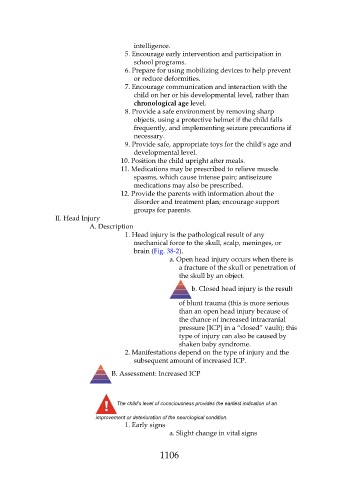Page 1106 - Saunders Comprehensive Review For NCLEX-RN
P. 1106
intelligence.
5. Encourage early intervention and participation in
school programs.
6. Prepare for using mobilizing devices to help prevent
or reduce deformities.
7. Encourage communication and interaction with the
child on her or his developmental level, rather than
chronological age level.
8. Provide a safe environment by removing sharp
objects, using a protective helmet if the child falls
frequently, and implementing seizure precautions if
necessary.
9. Provide safe, appropriate toys for the child’s age and
developmental level.
10. Position the child upright after meals.
11. Medications may be prescribed to relieve muscle
spasms, which cause intense pain; antiseizure
medications may also be prescribed.
12. Provide the parents with information about the
disorder and treatment plan; encourage support
groups for parents.
II. Head Injury
A. Description
1. Head injury is the pathological result of any
mechanical force to the skull, scalp, meninges, or
brain (Fig. 38-2).
a. Open head injury occurs when there is
a fracture of the skull or penetration of
the skull by an object.
b. Closed head injury is the result
of blunt trauma (this is more serious
than an open head injury because of
the chance of increased intracranial
pressure [ICP] in a “closed” vault); this
type of injury can also be caused by
shaken baby syndrome.
2. Manifestations depend on the type of injury and the
subsequent amount of increased ICP.
B. Assessment: Increased ICP
The child’s level of consciousness provides the earliest indication of an
improvement or deterioration of the neurological condition.
1. Early signs
a. Slight change in vital signs
1106

